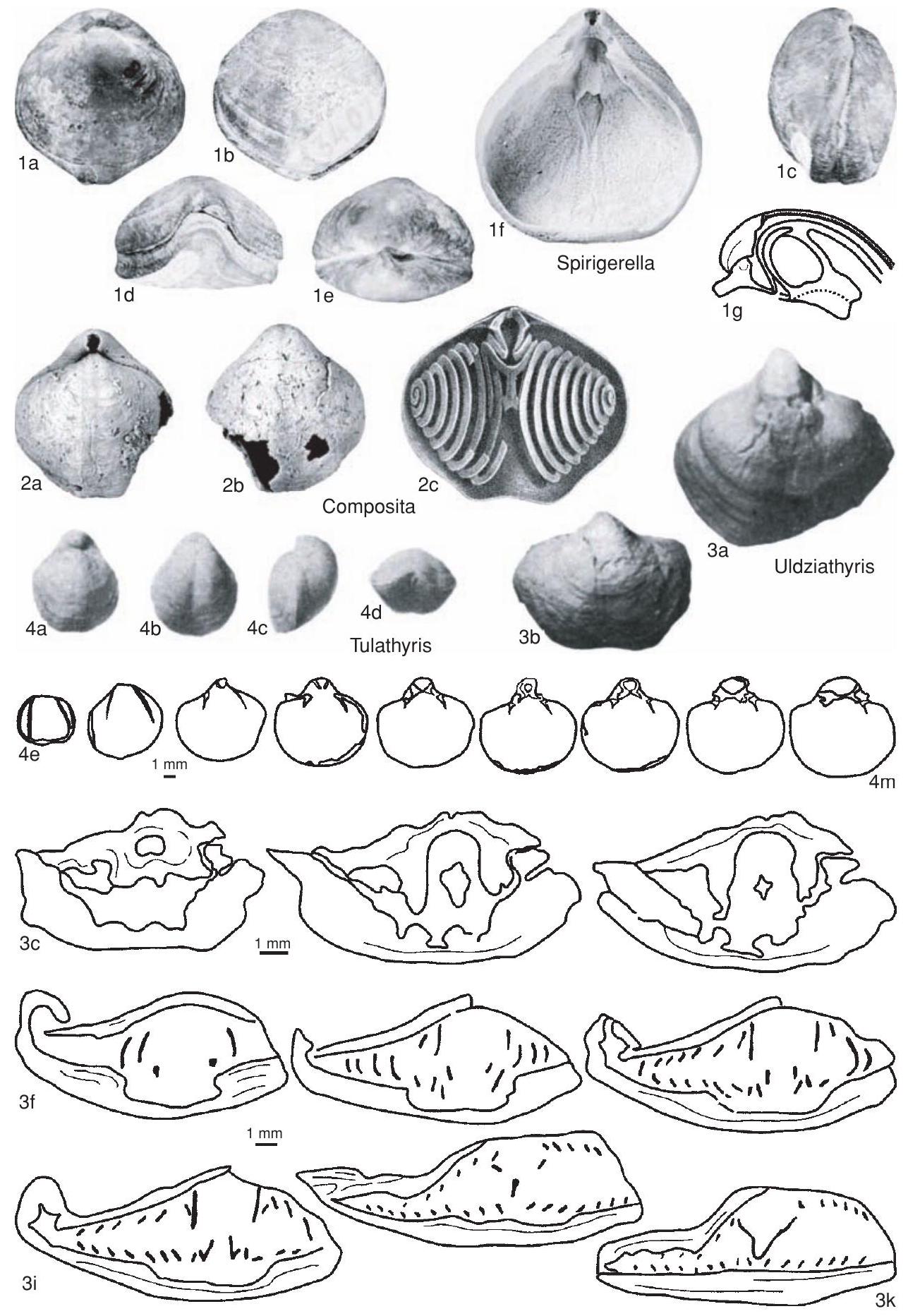Welcome to the Treatise on Invertebrate Paleontology!
Please enter a genera name to retrieve more information.

Spirigerella
Classification
Phylum:
Brachiopoda
Subphylum:
Rhynchonelliformea
Class:
Rhynchonellata
Order:
Athyridida
Suborder:
Athyrididina
Superfamily:
Athyridoidea
Family:
Athyrididae
Subfamily:
Spirigerellinae
Formal Genus Name and Reference:
Spirigerella WAAGEN , 1883, p. 450
Type Species:
S. derbyi; SD OEHLERT , 1887a, p. 1300
Images
(Click to enlarge in a new window)
Fig. 1043, 1a–g. *S. derbyi, Kazanian, Salt Range, Pakistan; a–e, holotype, dorsal, ventral, lateral, anterior, and posterior views, GSI 3407, Waagen collection, × 1 (new; photographs courtesy of R. K. Biswas); f, ventral interior, USNM 212888, × 2 (Grant, 1976); g, lateral view of jugum, approximately ×4 (Waagen, 1883). [See also Fig. 1002.2, p. 1477, and Fig. 1008.2, p. 1485, in introduction.]
Synonyms
Juxathyris
Geographic Distribution
Slovakia, Croatia, Hungary, Italy, Turkey, Iran, Pakistan, Nepal, Kashmir, western Malaysia, Timor, northeastern and southern China, Western Australia, Argentina
Age Range
Beginning Stage in Treatise Usage:
Upper Carboniferous
Beginning International Stage:
Bashkirian
Fraction Up In Beginning Stage:
0
Beginning Date:
323.4
Ending Stage in Treatise Usage:
Upper Permian
Ending International Stage:
Changhsingian
Fraction Up In Ending Stage:
100
Ending Date:
251.9
Description
Bi- to dorsibiconvex or convexiplane, isometric or subovate massive shells commonly widest anterior to midlength; strong, broad dorsal fold and ventral sulcus; uniplicate or parasulcate anterior commissure; ventral beak short, strongly incurved, concealing small foramen; nearly flat palintrope; dental plates, if present, buried in secondary shell material that is strongly developed in umbonal cavities; more or less developed delthyrial plate may be present; high, massive, cardinal plate; outer hinge plates reduced; cardinal flanges may be unified, strongly developed, serrated, ventrally concave, with deeply impressed pair of diductor pits; dorsal myophragm commonly present; jugum essentially as in Athyris, but lateral branches of jugum originating before valve midlength, projecting anteroventrally; median bladelike elevation on saddle extending backward as far as jugal stem; tertiary layer may be present apically. [Juxathyris, from Middle to Upper Permian of southern China, is said to differ by having inner socket ridges superseded by high and large processes that take the shape of phoenix coronet (sic).]
References
Museum or Author Information
Classification
Phylum:
Brachiopoda
Subphylum:
Rhynchonelliformea
Class:
Rhynchonellata
Order:
Athyridida
Suborder:
Athyrididina
Superfamily:
Athyridoidea
Family:
Athyrididae
Subfamily:
Spirigerellinae
Formal Genus Name and Reference:
Spirigerella WAAGEN , 1883, p. 450
Type Species:
S. derbyi; SD OEHLERT , 1887a, p. 1300
Images
(Click to enlarge in a new window)
Fig. 1043, 1a–g. *S. derbyi, Kazanian, Salt Range, Pakistan; a–e, holotype, dorsal, ventral, lateral, anterior, and posterior views, GSI 3407, Waagen collection, × 1 (new; photographs courtesy of R. K. Biswas); f, ventral interior, USNM 212888, × 2 (Grant, 1976); g, lateral view of jugum, approximately ×4 (Waagen, 1883). [See also Fig. 1002.2, p. 1477, and Fig. 1008.2, p. 1485, in introduction.]
Synonyms
Juxathyris
Geographic Distribution
Slovakia, Croatia, Hungary, Italy, Turkey, Iran, Pakistan, Nepal, Kashmir, western Malaysia, Timor, northeastern and southern China, Western Australia, Argentina
Age Range
Beginning Stage in Treatise Usage:
Upper Carboniferous
Beginning International Stage:
Bashkirian
Fraction Up In Beginning Stage:
0
Beginning Date:
323.4
Ending Stage in Treatise Usage:
Upper Permian
Ending International Stage:
Changhsingian
Fraction Up In Ending Stage:
100
Ending Date:
251.9
Description
Bi- to dorsibiconvex or convexiplane, isometric or subovate massive shells commonly widest anterior to midlength; strong, broad dorsal fold and ventral sulcus; uniplicate or parasulcate anterior commissure; ventral beak short, strongly incurved, concealing small foramen; nearly flat palintrope; dental plates, if present, buried in secondary shell material that is strongly developed in umbonal cavities; more or less developed delthyrial plate may be present; high, massive, cardinal plate; outer hinge plates reduced; cardinal flanges may be unified, strongly developed, serrated, ventrally concave, with deeply impressed pair of diductor pits; dorsal myophragm commonly present; jugum essentially as in Athyris, but lateral branches of jugum originating before valve midlength, projecting anteroventrally; median bladelike elevation on saddle extending backward as far as jugal stem; tertiary layer may be present apically. [Juxathyris, from Middle to Upper Permian of southern China, is said to differ by having inner socket ridges superseded by high and large processes that take the shape of phoenix coronet (sic).]
